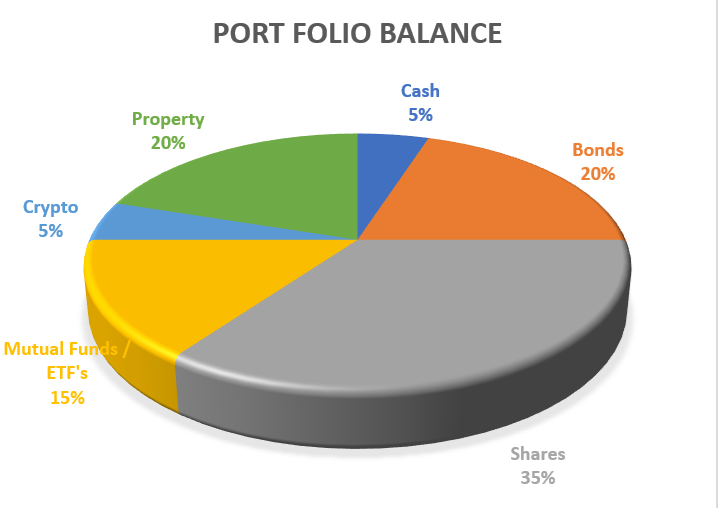Portfolio
Between cash, bonds, funds, shares, cryptocurrency and property, what is a reasonably well-balanced an diversified portfolio?

1, Real Estate
2. Index funds & ETF’s
3. Divident stocks
4. Private equity & business ownership
5. Farmland invetstments
6. Precious metals
7. Timberland & natural resources
8. Fine art and collectibles
9. Cryotocurrency & blockchain technology
10. Intellectual property
11. High yield bonds & Treasury securities
12 Luxury assets as investments
13. Wine &whiskey
14. Rare books & 1st editions
15. Cash-flowing websites
16. Media companies & content creation
17,. Life insurance with cash value
18. Private lending strategies
19. Luxury rental businesses
20. Financial education
1, Mutual & Index funds eg S&P 500
2. Cash – Peer – peer lending
3. Real Estate – Appreciation, income
4. Bonds – 3% annual returns
5. Stocks – dividends,
6. Trademarks
7. Brand & Goodwill
8. People – most valuable
9. Commodities – buy low, sell high e.g. gold, art, vintage cars
10. Books, songs, digital content, products, courses.
11. Royalties – TV shows, books etc
12 Franchises.
13. Collectibles e.g. rare coins, cars, books, wines at auctions
14. Angel investing.
15. Intellectual property (IP) e.g. Trademark, copyrights
16. Life insurance policies – cash value growth
17. Peer – peer lending
18. High quality businesses – franchise, buy undervalued business, build & sell.
19. Unique rights e.g. – patent for unique technologies (exclusivity)
20. 1st mover advantage in proprietary business modules. eg Air B-n-B
A well-balanced and diversified portfolio typically depends on factors like your risk tolerance, investment goals, and time horizon. However, a reasonable allocation for a balanced investor might look something like this:
1. Cash (10-15%)
- Purpose: Liquidity and emergency funds.
- Includes: Savings accounts, fixed deposits, money market funds.
- Pros: Stability and accessibility.
- Cons: Low returns, especially after inflation.
2. Bonds (20-30%)
- Purpose: Stability and income generation.
- Includes: Government bonds, corporate bonds, inflation-protected bonds.
- Pros: Lower risk than stocks, provides steady returns.
- Cons: Interest rate risk, lower growth potential.
3. Funds (Mutual Funds & ETFs) (20-30%)
- Purpose: Diversification with professional management.
- Includes: Equity funds, balanced funds, index ETFs.
- Pros: Reduces the risk of picking individual stocks, good for long-term growth.
- Cons: Management fees, less control over individual assets.
4. Shares (Individual Stocks) (20-30%)
- Purpose: Growth and capital appreciation.
- Includes: Blue-chip stocks, growth stocks, dividend stocks.
- Pros: High return potential, ability to pick specific sectors.
- Cons: Volatility, requires research and monitoring.
5. Cryptocurrency (5-10%)
- Purpose: High-risk, high-reward speculation.
- Includes: Bitcoin, Ethereum, altcoins.
- Pros: Potential for high returns, emerging asset class.
- Cons: Extreme volatility, regulatory risk, security concerns.
6. Property (10-25%)
- Purpose: Inflation hedge, passive income, long-term growth.
- Includes: Residential, commercial, real estate investment trusts (REITs).
- Pros: Tangible asset, rental income, potential for appreciation.
- Cons: Illiquid, maintenance costs, property market fluctuations.
Key Adjustments Based on Risk Appetite:
- Conservative Investor → More bonds and cash, less stocks and crypto.
- Balanced Investor → Equal mix of stocks, bonds, and property, with some crypto.
- Aggressive Investor → Higher allocation to stocks, funds, and crypto, less in bonds/cash.
For a 5-year investment horizon, you’ll need a portfolio that balances growth potential with risk management since five years is relatively short for high-risk assets to recover from potential downturns. A balanced approach could look like this:
Suggested 5-Year Portfolio Allocation
| Asset Class | Allocation (%) | Purpose & Risk Level |
|---|---|---|
| Cash & Money Market | 10-15% | Emergency funds, short-term liquidity. Low risk. |
| Bonds (Govt & Corporate) | 25-30% | Stability, fixed returns, and lower volatility. Medium risk. |
| Funds (ETFs & Mutual Funds) | 20-25% | Diversification across stocks & bonds. Medium risk. |
| Shares (Individual Stocks) | 20-25% | Growth potential, but with market volatility. Higher risk. |
| Cryptocurrency | 5-10% | High-risk, high-reward exposure to digital assets. Very high risk. |
| Property (REITs or Direct Investment) | 10-20% | Inflation hedge, rental income, and potential capital appreciation. Medium risk. |
Key Considerations for a 5-Year Term:
✅ Less Volatility – A shorter timeframe means you can’t afford deep market downturns. More bonds and diversified funds provide stability.
✅ Moderate Growth Exposure – Stocks still play a key role for returns but should be carefully selected (large-cap, dividend-paying, or defensive sectors).
✅ Liquidity – Having cash and liquid assets (money market funds, short-term bonds) ensures access to funds without forced selling.
✅ Real Estate Exposure – If direct property investment is too illiquid, consider Real Estate Investment Trusts (REITs) for diversification.
✅ Crypto Caution – Given the volatility, limit exposure to 5-10%, focusing on established assets like Bitcoin & Ethereum.
Adjustments Based on Risk Preference:
- More Conservative? Increase bonds (40%) and cash (20%), reduce crypto (0-5%) and stocks (10-15%).
- More Aggressive? Increase stocks (35-40%) and crypto (10-15%), lower bonds (15%) and cash (5-10%).
Disclaimer.
The contents of this site should not be taken as financial advice. The owners take no responsibility for any information presented here. You should seek professional advice before investing your hard-earned money. You should never invest money you are not ready to lose. Please speak to an independent professional advice before you invest any money.